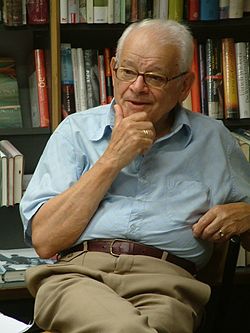Dutch Jewish historian (1921-2016)
Jules Schelvis
|
|---|
 Schelvis in 2006
|
| Born
| (
1921-01-07
)
7 January 1921
|
|---|
| Died
| 3 April 2016
(2016-04-03)
(aged 95)
|
|---|
| Nationality
| Dutch
|
|---|
| Occupation(s)
| Historian, author,
Nazi hunter
|
|---|
| Spouse
|
Rachel Borzykowski
(
m.
1940; died 1943)
|
|---|
Jules Schelvis
(7 January 1921 ? 3 April 2016) was a
Dutch Jewish
historian, writer, printer, and
Holocaust survivor
. Schelvis was the sole survivor among the 3,005 people on the 14th
transport
from
Westerbork
to
Sobibor extermination camp
, having been selected to work at nearby
Dorohucza labour camp
. He is known for his memoirs and historical research about Sobibor, for which he earned an honorary doctorate from the
University of Amsterdam
, Officier in the
Order of Orange-Nassau
, and
Order of Merit of the Republic of Poland
.
Schelvis was born in Amsterdam, part of a secular Jewish family. After high school, he trained as a printer and worked for Printing Office Lindenbaum in Amsterdam. He worked at various newspapers and participated in a local youth labour organization, where he met and courted a woman named Rachel Borzykowski. Schelvis grew close to Borzykowski and her family, whose residence was a local center of
Yiddish culture
. Schelvis and Borzykowski married in 1941, partly in the hope that this would protect her and her
Polish Jewish
immigrant family from deportation.
[1]
However, Schelvis and his family were rounded up in
Amsterdam
on 26 May 1943. They were deported to
Westerbork transit camp
, where they spent six days before being sent to
Sobibor extermination camp
. They were among the 3,005 Dutch Jews on the 14th
transport
to Sobibor. The journey lasted for 4 days. At the Sobibor arrival ramp, Schelvis was selected to join a work unit sent to
Dorohucza labor camp
. The rest of his family and the Borzykowskis were gassed immediately.
[2]
At Dorohucza, Polish and Dutch Jews were forced to work in abominable conditions building latifundia for
Generalplan Ost
. Schelvis survived because he asked for a meeting with the camp commandant, who happened to be aware that another nearby labor camp needed a printer. However, for unclear reasons, Schelvis was instead sent to
Lublin airfield camp
, where he was forced to build barracks. From there, he was transferred to
Radom Ghetto
, where he was tasked with reassembling a printing press which had been disassembled for transport from
Warsaw
. Conditions in Radom where significantly better than Schelvis had experienced in Lublin or Dorohucza. With the
Red Army
approaching, Schelvis was sent on a
death march
to
Tomaszow Mazowiecki
. From there he eventually reached Vaihingen near Stuttgart, where he was liberated by the French army on 8 April 1945.
[2]
Schelvis was a
plaintiff
and
expert witness
during the trials of
Karl Frenzel
,
John Demjanjuk
, among other Holocaust perpetrators.
[2]
[3]
He is the founder of Stichting Sobibor as well as the author of several memoirs and historical studies about Sobibor.
[4]
Notable works
[
edit
]
References
[
edit
]
|
|---|
| Camp organizers
| |
|---|
| Commandant
| |
|---|
| Deputies
| |
|---|
Gas chamber
executioners
| |
|---|
| Other officers
| |
|---|
| Guards
| |
|---|
| |
|---|
| Nazi organizations
| |
|---|
| |
|---|
| Related topics
| |
|---|
- a
28 April to 30 August 1942
- b
1 September 1942 to 17 October 1943
- c
Up to 200
|
|
|---|
| By territory
| |
|---|
| Overview
| |
|---|
| Response
| |
|---|
|
|
|
|
- Early elements
- Aftermath
- Remembrance
|
|---|
|
|
|
|---|
| International
| |
|---|
| National
| |
|---|
| People
| |
|---|
| Other
| |
|---|